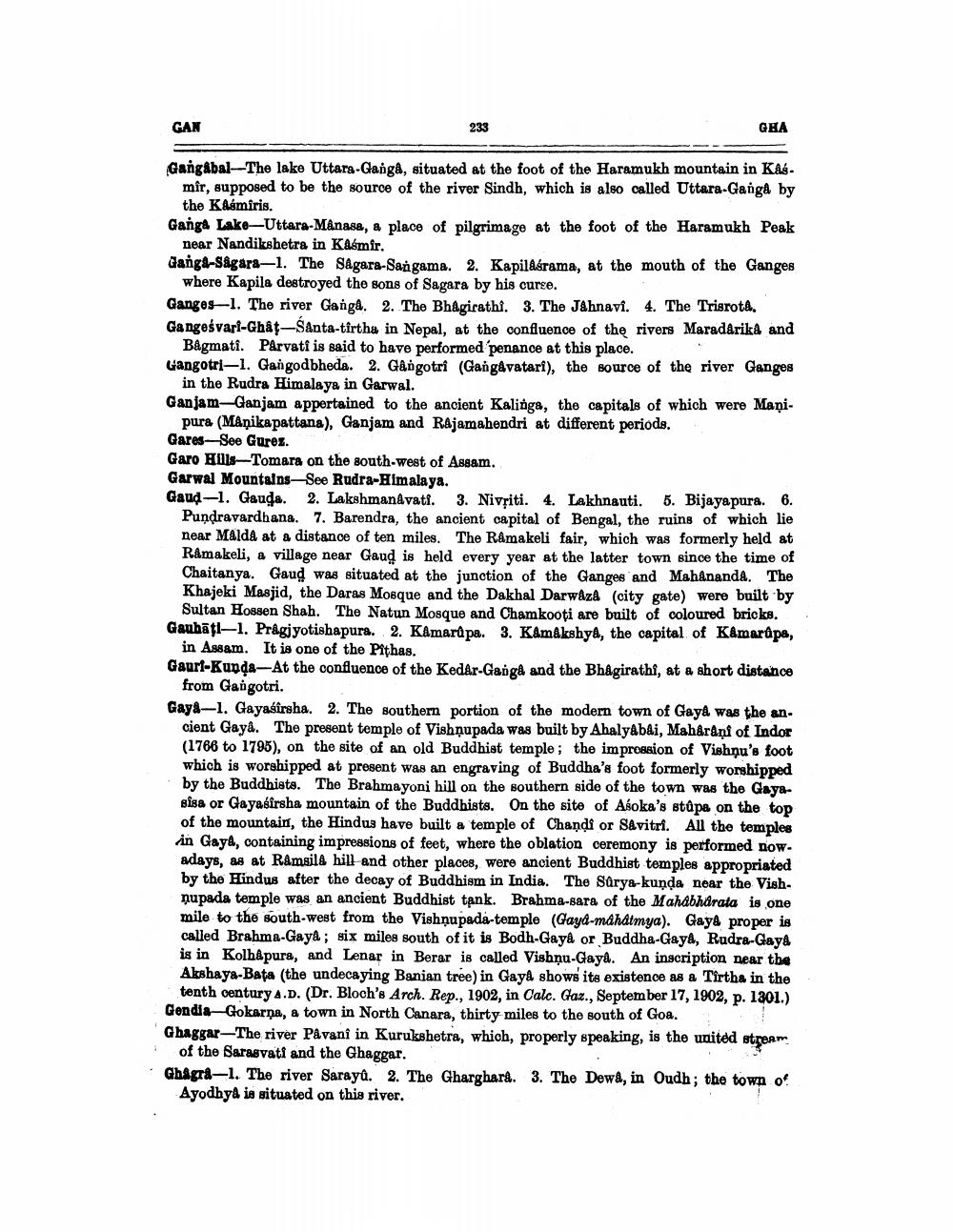________________
GAN
233
GHA
Gangåbal-The lake Uttara-Gangå, situated at the foot of the Haramukh mountain in Kas
mir, supposed to be the source of the river Sindh, which is also called Uttara-Gangå by
the Kasmiris. Ganga Lake-Uttara-Manasa, a place of pilgrimage at the foot of the Haramukh Peak
near Nandikshetra in Kasmir. Gangl-Sagara-1. The Sagara-Saá gama. 2. KapilAsrama, at the mouth of the Ganges
where Kapila destroyed the sons of Sagara by his curse. Ganges-1. The river Ganga. 2. The Bhagirathi. 3. The Jahnavi. 4. The Trisrota. Gangesvarl-Ghat-Santa-tirtha in Nepal, at the confluence of the rivers Maradarika and
Bagmati. Parvati is said to have performed 'penance at this place. Gangotri-1. Gangodbheda. 2. Gangotri (Gangavatari), the source of the river Ganges
in the Rudra Himalaya in Garwal. Ganjam-Ganjam appertained to the ancient Kalinga, the capitals of which were Maņi.
pura (MAņikapattana), Ganjam and Rajamahendri at different periods. Gares See Gurez. Garo Hills-Tomara on the south-west of Assam. Garwal Mountains See Rudra-Himalaya. Gaud-1. Gauda. 2. Lakshmanavati. 3. Nivriti. 4. Lakhnauti. 5. Bijayapura. 6.
Pundravardhana. 7. Barendra, the ancient capital of Bengal, the ruins of which lie near MaldA at a distance of ten miles. The Ramakeli fair, which was formerly held at Råmakeli, a village near Gaud is held every year at the latter town since the time of Chaitanya. Gaud was situated at the junction of the Ganges and MahAnanda. The Khajeki Masjid, the Daras Mosque and the Dakhal Darwaza (city gate) were built by
Sultan Hossen Shah. The Natun Mosque and Chamkooti are built of coloured bricks. Gauhāti-1. Pragjyotishapura. 2. Kamarapa. 3. Kamakshya, the capital of Kamarûpe,
in Assam. It is one of the Pithas. Gaurt-Kunda-At the confluence of the Ked&r-Ganga and the Bhagirathi, at a short distance
from Gangotri. Gaya-1. Gayasîrsha. 2. The southern portion of the modern town of Gayê was the an
cient Gaya. The present temple of Vishnupada was built by Ahalyabdi, Maharani of Indor (1766 to 1795), on the site of an old Buddhist temple; the impronsion of Vishnu's foot which is worshipped at present was an engraving of Buddha's foot formerly worshipped by the Buddhists. The Brahmayoni hill on the southern side of the town was the Gayasisa or Gayasîrsha mountain of the Buddhists. On the site of Asoka's stûpa on the top of the mountain, the Hindus have built a temple of Chandi or S&vitri. All the temples in Gaye, containing impressions of feet, where the oblation ceremony is performed now. adays, as at Ramsila hill and other places, were ancient Buddhist temples appropriated by the Hindus after the decay of Buddhism in India. The Sarya-kunda near the Vishnupada temple was an ancient Buddhist tank. Brahma-bara of the Mahabharata is one mile to the south-west from the Vishnupada-temple (Gaya-mahatmya). Gay& proper is called Brahma-Gaya; six miles south of it is Bodh Gaya or Buddha-Gaya, Rudra-Gaya is in Kolhapura, and Lenar in Berar is called Vishnu-Gaya. An inscription near the Akshaya-Bata (the undecaying Banian tree) in Gay& shows its existence as a Tirtha in the
tenth century A.D. (Dr. Bloch's Arch. Rep., 1902, in Calc. Gaz., September 17, 1902, p. 1301.) Gendia-Gokarna, a town in North Canara, thirty miles to the south of Goa. Ghaggar-The river Pávani in Kurukshetra, which, properly speaking, is the united stream
of the Sarasvati and the Ghaggar. Ghagra-1. The river Sarayd. 2. The Gharghara. 3. The Dewa, in Oudh; the town of
Ayodhya is situated on this river.




